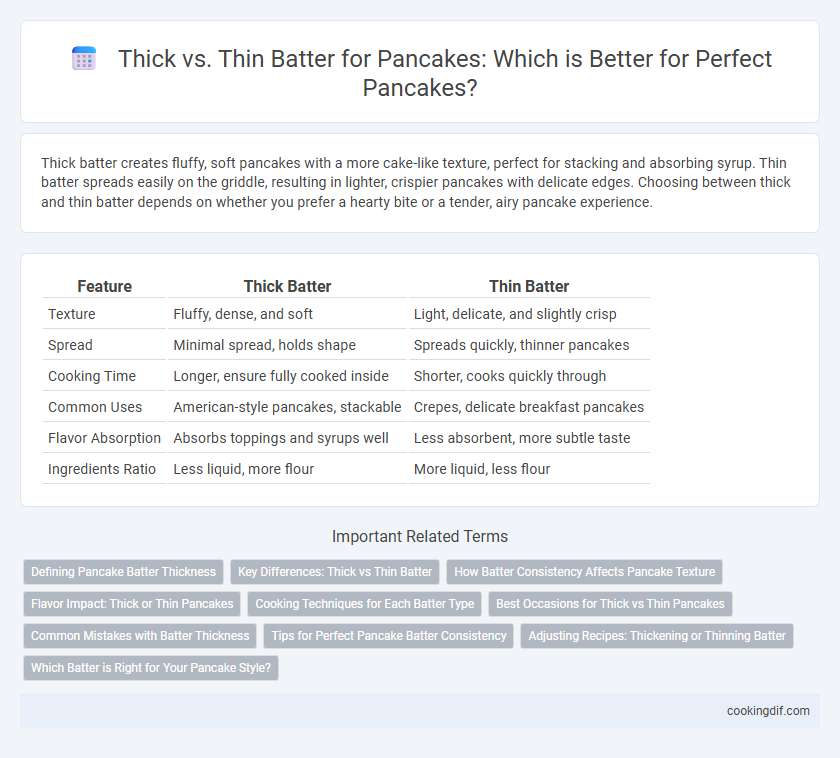Thick batter creates fluffy, soft pancakes with a more cake-like texture, perfect for stacking and absorbing syrup. Thin batter spreads easily on the griddle, resulting in lighter, crispier pancakes with delicate edges. Choosing between thick and thin batter depends on whether you prefer a hearty bite or a tender, airy pancake experience.
Table of Comparison
| Feature | Thick Batter | Thin Batter |
|---|---|---|
| Texture | Fluffy, dense, and soft | Light, delicate, and slightly crisp |
| Spread | Minimal spread, holds shape | Spreads quickly, thinner pancakes |
| Cooking Time | Longer, ensure fully cooked inside | Shorter, cooks quickly through |
| Common Uses | American-style pancakes, stackable | Crepes, delicate breakfast pancakes |
| Flavor Absorption | Absorbs toppings and syrups well | Less absorbent, more subtle taste |
| Ingredients Ratio | Less liquid, more flour | More liquid, less flour |
Defining Pancake Batter Thickness
Pancake batter thickness directly influences the texture and cooking time, with thick batter producing fluffy, dense pancakes that hold shape well on the griddle. Thin batter spreads easily, resulting in crepe-like pancakes with a delicate, tender bite and faster cooking. The ideal batter consistency balances viscosity to achieve desired pancake thickness and fluffiness, often measured by the batter's ability to flow slowly off a spoon without being runny.
Key Differences: Thick vs Thin Batter
Thick pancake batter creates fluffy, dense pancakes with a soft interior and a slightly crispy exterior, while thin batter results in lighter, thinner, and more delicate pancakes with a crepe-like texture. The ratio of flour to liquid determines batter thickness, with more flour producing thicker batter and more liquid yielding a thinner consistency. Adjusting batter thickness affects cooking time, texture, and flavor absorption, making it essential for achieving desired pancake results.
How Batter Consistency Affects Pancake Texture
Thick pancake batter produces dense, fluffy pancakes with a soft interior and a slightly crisp exterior due to slower heat penetration and less spreading on the griddle. Thin batter results in lighter, thinner pancakes that cook quickly with a chewier texture and more even browning. Adjusting water or milk content directly influences this consistency, allowing control over the pancake's final texture and mouthfeel.
Flavor Impact: Thick or Thin Pancakes
Thick pancake batter creates dense, fluffy pancakes that absorb syrups and toppings, intensifying flavor with every bite. Thin batter yields delicate, crispy-edged pancakes that enhance the buttery, caramelized notes during cooking. Choosing between thick or thin batter ultimately shapes the texture and flavor profile, influencing the overall pancake experience.
Cooking Techniques for Each Batter Type
Thick pancake batter requires gentle folding to maintain airiness and is best cooked on a medium-low heat to ensure even cooking without burning the exterior. Thin batter spreads quickly, needing a higher heat and faster flipping to achieve a crisp edge and avoid overcooking. Adjusting heat and flip timing based on batter consistency optimizes texture and flavor for each pancake style.
Best Occasions for Thick vs Thin Pancakes
Thick pancake batter creates fluffy, hearty pancakes ideal for brunches or weekend breakfasts where indulgence and volume are desired. Thin batter results in delicate, crepe-like pancakes perfect for quick meals, light desserts, or paired with sweet and savory fillings during festive occasions. Choosing between thick or thin batter depends on the mood and setting, with thick pancakes suiting leisurely gatherings and thin pancakes fitting elegant or fast-paced dining experiences.
Common Mistakes with Batter Thickness
Using batter that is too thin often results in pancakes that spread excessively and cook unevenly, producing a flat and rubbery texture. Conversely, overly thick batter can cause pancakes to remain raw in the center while becoming burnt on the outside due to longer cooking times. Achieving the ideal pancake batter consistency, resembling heavy cream, prevents these common mistakes and ensures fluffy, evenly cooked pancakes.
Tips for Perfect Pancake Batter Consistency
Achieving the perfect pancake batter consistency depends on balancing flour and liquid ratios; thick batter produces fluffy, tall pancakes while thin batter yields delicate, crepe-like results. Use a whisk to gently combine ingredients without overmixing, ensuring some lumps remain for tender texture. For best results, adjust thickness by adding milk incrementally and test with a small skillet portion before cooking the entire batch.
Adjusting Recipes: Thickening or Thinning Batter
Adjusting pancake batter consistency plays a crucial role in achieving desired texture and fluffiness. Thicker batter, enhanced by adding extra flour or reducing liquid, yields denser, fluffy pancakes with a rich mouthfeel. Conversely, thinning batter with more milk or water produces thinner, crisper pancakes with a delicate edge and faster cooking time.
Which Batter is Right for Your Pancake Style?
Thick pancake batter, rich in flour and leavening agents, produces fluffy, soft pancakes ideal for stackable breakfast plates, while thin batter spreads easily for crepe-style pancakes with a delicate, crisp texture. Choosing the right batter depends on your preferred pancake style: thick batter suits hearty, fluffy pancakes that soak up syrup, whereas thin batter is perfect for light, versatile pancakes that can be filled or rolled. Adjusting the ratio of liquid to flour directly impacts the pancake's density and cooking time, tailoring your breakfast experience to classic American or European traditions.
Thick vs thin batter for pancakes Infographic

 cookingdif.com
cookingdif.com